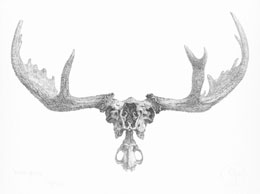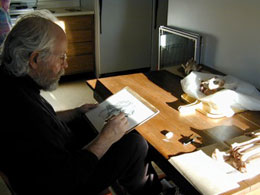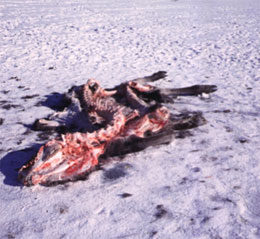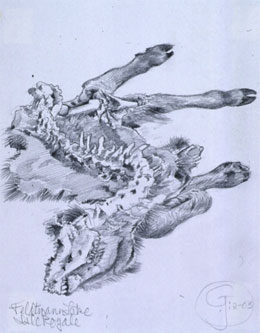
So much to say about this piece... the subject, the artist, the medium, the title... But first, simply take a moment to observe it, to enjoy it without knowing everything about it...
Now, let’s begin with the title.
Minong is the ancient Ojibwa name for Isle Royale. The meaning of “minong” was lost to us when European colonists to North American committed genocide on these people. has been obscured by maltreatment of Ojibwa culture, though it likely refers to Isle Royale’s ancient namesake, "The Place of Blue Berries."
Minongers represents a bull moose skull balanced upon the nose of a wolf skull.
The moose skull represents a bull that died in the autumn of 1995 at the age of 14 years. Autumn is an unusual time for a moose to die. Typically, they are in prime condition. However, sometimes an older moose will put so much energy into the rut, they it will cost the bull its life.
This moose also had signs of arthritis and osteoporosis in his skeleton - signs of senescence. Its skull is adorned with the largest pair of antlers ever found on Isle Royale. Although huge, the antlers are a bit asymmetrical - another sign of pouring all his energy into antler growth.
The wolf skull represents the alpha female of Middle Pack. During her life she had only one mate, the alpha male of Middle Pack. She ruled the females of Middle Pack for 5 years. Their lives were not easy. During their lives, they probably killed about 250 moose. It wasn't needless murder. It was a heroic means by which to survive and raise their offspring. She probably raised only 4 surviving pups. In January 1994, the male died.
One month later, she died. She starved to death. Her body weighted only 47 lbs. They were both about 10 years old.
Her heritage continued on. One of her male pups found a mate in a dispersing female, and Middle Pack continued. Today, Middle Pack is lead by a wolf that may be the grandson of the wolf depicted in Minongers.

In the evening hours, Gendron worked in the make-shift studio that we were able to provide him during his time at winter study.
Gendron Jensen's life is devoted to sharing the beauty and mystery of bones through his drawings. To learn more about Gendron Jensen and his art, visit his webpage, where you can also purchase a limited edition copy of Minongers.
In February 2003, Gendron joined our research team during that year’s winter field season. His aim was to create and share artistic expressions of the drama experienced by the lives and deaths of Isle Royale wolves and moose. With that visit Gendron created several exquisite expressions.
By daylight hours Gendron spent his time working with what nature provided.
On February 12th, Middle Pack had killed a calf on the northwest corner of Feldtmann Lake. All that remained were bones, blood-stained snow, and some hide. Gendron wanted to draw these remains, as a tribute to the circle of life and death that connects the wolves and moose of Isle Royale.

A photographic representation of the site.
Don Glaser, our pilot, flew Gendron to the site so that he could spend the day there drawing. It was cold, by any measure. But it was really cold, if your plan was to draw without wearing any gloves.
Don left Gendron with these instructions: In a couple of hours, I'll fly by to see if you need anything. If you need anything, wave to me, and I'll land; otherwise, I'll just fly right on by. So, if you need anything, just wave to me, and I'll land. Otherwise, there will be no need to wave. You'll see me, and I'll see you, and there'll be no need to wave. You don't need to wave to be friendly or let me know you're having a wonderful time. I'll know that. Wave only if you want me to land.
Tough instructions for someone with as much joy and expression as Gendron. A couple hours later Don flew by. Gendron didn't need anything, except to let someone know how full of joy he was to be drawing the remains of an Isle Royale moose calf killed by wolves on Feldtmann Lake - absolutely full of joy. Gendron didn't want Don to land, because there was no material need.
Don recalls being able to see the restraint in Gendron's body: "He seemed to sit on his hands, and dared not even look at me for fear of that being interpreted as a wave. Gendron did no more than look out the corner of his eye as I flew by. I got the message: Gendron was having the time of his life, but didn't need anything at the moment, except more time to draw."

Gendron’s expression of the site rendered in graphite pencil on paper.
“I could only achieve two field drawings with pencil, since conditions were so severe that day, during my 4-1/2 hours of intense beholdeness. Ravens called in distant conifers along the shore to East. Canada jays cautiously came out near the kill on ice. One lone seagull landed at a respectful distance out on lake to watch me and two foxes were in attendance. One was so lively and bold, coming almost within reach as I drew. The others stayed on shoreline and in forest thickets being kept there by the hostile advances of first fox to have arrived from across the lake on ice. The very stinging pungent smell of the moose was thick in the air.”
The Minongers is a lithograph. Lithography is a complex process and has a long history. It was first developed in the late 18th century, and was the first major development in printing since the 15th century. For more than 100 years lithography was the most sophisticated way to mass produce high quality images.
Lithography entails drawing an image on a large, smooth limestone tablet using wax pencils. Next, the stone tablet is washed in acid. The acid eats away at the stone that is not covered by the wax lines. After the acid bath, the wax is washed away and the stone tablet is covered in ink and pressed onto paper. The high parts of the tablet (i.e., those which had been protected by the wax lines) are recorded in ink on paper. After, making numerous prints of this kind, the surface of stone tablet is then ground smooth, destroying the image and readying it to receive the next artistic creation.